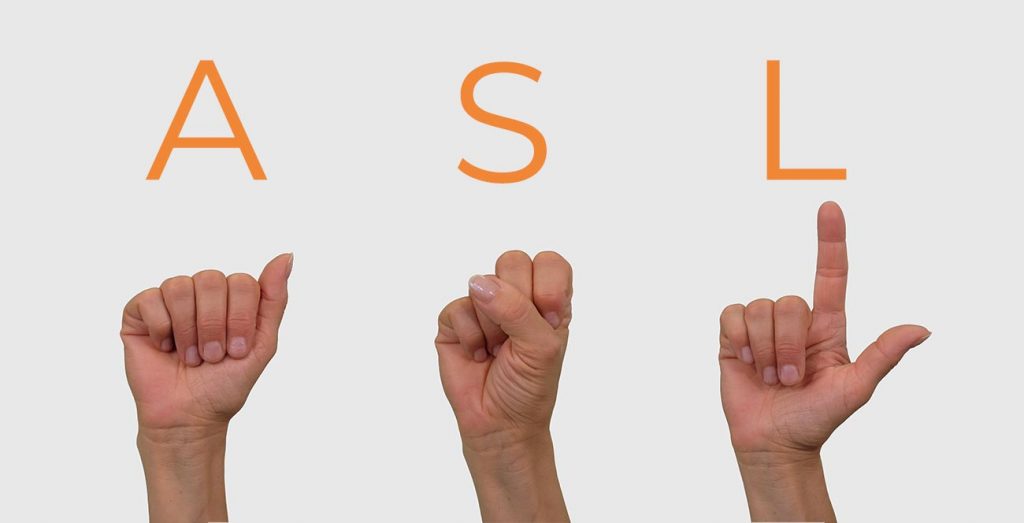Did you already ask yourself, what’s the best way to learn ASL? Here are some great tips for improving your ASL skills faster! Learning a sign language will become more fun if you try some of the following tips.
1. Learn the 100 most important vocabulary
To start communicating, you need to know some basic vocabulary. That’s why at the beginning of your ASL journey you should aim to learn the essentials, like “hello”, “thanks” or “please”.
As soon as you know some words you can start getting into a conversation:
2. Learn the finger alphabet
It is vital to learn the ASL alphabet when you start out with American Sign Language. Knowing the alphabet will give you the skill to sign any word. So, if you forget a sign you can simply spell it.
To become better at fingerspelling, try to spell objects you see around yourself like C-O-M-P-U-T-E-R or T-R-E-E. Lingvano premium users have access to our finger alphabet trainer, which helps to improve fingerspelling skills.

3. Learn to sign the phrase “How do I sign … ?”
As soon as you know the finger alphabet and the phrase “How do I sign … (spelled word)?”, you can ask for any sign. So, let’s learn this phrase.
4. Conversation!
Don’t wait before getting into conversations and start to sign right away! As soon as you know some basic words and the alphabet don’t hesitate to approach other ASL users. Making conversation is key to learning any language. Many language learners make the mistake and wait too long before communicating with other people.
5. Find a practice buddy or join the local Deaf community
To make conversation you need people to interact with. Most cities or towns have a local Deaf community. Visit meetups and surround yourself with people who know how to sign.
If you live far away from a big city, try to find a practice buddy via the internet (e.g. in Facebook groups). You can communicate with your buddy through video calls!
6. Don’t worry about understanding everything
Lots of language learners are afraid that they will not understand everything when communicating with other people.
It’s not important to understand every sign of a sentence. Just try to get the overall meaning of the sentences. Your skills will constantly improve and it will become easier to understand the content.
In most cases, the people you are signing with are empathic and open to help any time you are struggling to understand the meaning of the sentence.
7. Learn phrases you frequently use
Learn some key phrases which are important to you. This will make you more fluent, especially when making small talk!
8. Be aware of an unsteady learning curve
Keep in mind that everyone has bad days. On some days you might feel like you’ve forgotten all signs and you’re not making any progress. Do not let such emotions take away your motivation. The learning progress is not linear like most people believe. It’s often bumpy, but in the long run, your skills are rising.

9. Build great habits
Keep in mind that consistency is more important than intensity. Learn ASL every day! You don’t have to learn for an hour each day. 5-10 minutes are enough to improve your skills. Just try to keep it rolling!
10. Make mistakes! Be childlike. Don’t worry about perfection
One reason why children generally learn faster than adults is that they are not afraid to make mistakes. Making mistakes is one of the most important parts of the learning process. Still, most of us adults are self-conscious and feel like they should not make mistakes. Don’t be afraid to make mistakes. Act more childlike and learn faster. Nobody will judge you.
11. Use the Pareto principle
Did you hear about the Pareto principle also known as 80/20 rule?
The Pareto principle says, that roughly 80% of the effects come from 20% of the causes. Transferred to language learning this means that 20% of things you learn contribute to 80% of your total ASL improvement. In other words, only a small proportion of your learning input is driving a large part of your learning progress.
In language learning, the important part which is driving the learning progress is simply engaging with the language! Listening, reading, and speaking! Don’t get lost spending too much time on learning grammar or rarely used vocabulary.
12. Find your favorite YouTuber
Immerse yourself in ASL. Go on social media and find your favorite channels. Being surrounded by ASL will boost your progress and make learning ASL more fun!
Popular Deaf YouTube channels are:
- Signed with Heart – https://www.youtube.com/c/signedwithheart/
- Deafies in Drag – https://www.youtube.com/c/DeafiesinDrag/
- Deafinitely Dope – https://www.youtube.com/channel/UCC5MIgD3lTZkKzTahvoJ9Kw
- What the Deaf?! – https://www.youtube.com/channel/UChlvmpkvgsc2fR9rAVTYQew
- Sign Duo – https://www.youtube.com/channel/UCET0ZgnCFLi1369c3ZWfSFA
13. Track your progress
Tracking your progress will motivate you to keep learning ASL. Making weekly videos of yourself while signing is a great way to track your progress. You could keep the videos for yourself to view them some months later or share them on social media. They are a great memory of your ASL journey.
14. Set goals
You might get more motivation by setting daily, weekly, or monthly goals. Here are some examples:
- Learn 5 signs every day
- Have one conversation in sign language each week
- Learn 20 phrases each month
- Review the finger alphabet using the Lingvano finger alphabet trainer every day

15. Keep it fun and remember your “why”
This is the most important advice. Keep learning ASL fun! If you do not enjoy learning ASL you will most probably lose motivation and stop learning.
Also, remember why you are learning sign language. Knowing your goal will keep you learning.
Start learning Sign Language for free
Connect with Deaf relatives, friends, or colleagues and learn American Sign Language with the Lingvano App. Sign up for free and join more than 2 Million learners worldwide! Start Learning
Connect with Deaf family relatives, colleagues or friends and learn American Sign Language with the Lingvano App.
Start Learning No thanks